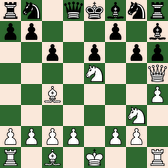I expect Emanuel Lasker (1868-1941) to provide more examples of a master exploiting the common, weak, airy pawn structure than other world champions. Lasker — champion for a record 27 years (1894-1921) — let opponents hang themselves. If you let them, opponents will set up that unsatisfactory pawn structure on their own; it’s more brutal when you force them to.
Source image for thumbnails.
